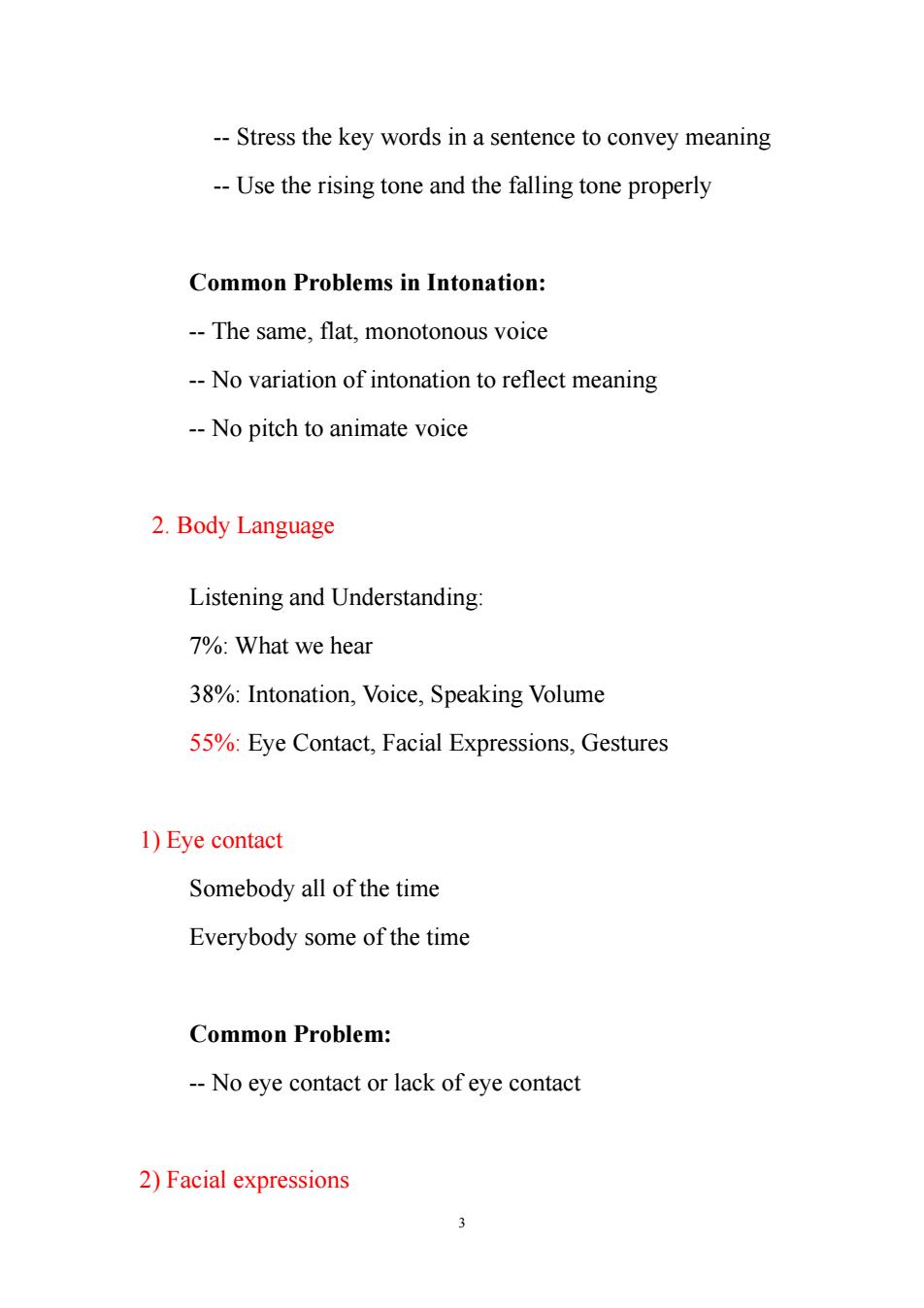
Presentation Skills Unit Five Presentation Skills--Delivery Il.Presentation Delivery It's common in class to find: 台上:侃侃而谈,头头是道 台下:云遮雾绕,乱云飞渡 Different Feelings: The Speaker's Feeling:我说清楚了,对方听懂了 The Audience's Feeling:你说得不清楚,我也没听懂 What is important in the presentation delivery? 1.Voice a.Use your voice to show your enthusiasm about the presentation. b.Try to vary your voice in at least three ways: 1)Speaking volume a.Vary your speaking volume. (You can speak at normal volume.You can speak loudly and you can speak quietly.But you must speak loud enough so that everybody can hear you clearly throughout the presentation. b.Be ready to adjust (size of the room,number of people
1 Presentation Skills Unit Five Presentation Skills -- Delivery II. Presentation Delivery It’s common in class to find: 台上:侃侃而谈, 头头是道 台下:云遮雾绕,乱云飞渡 Different Feelings: The Speaker’s Feeling: 我说清楚了,对方听懂了 The Audience’s Feeling: 你说得不清楚,我也没听懂 What is important in the presentation delivery? 1. Voice a. Use your voice to show your enthusiasm about the presentation. b. Try to vary your voice in at least three ways: 1) Speaking volume a. Vary your speaking volume. (You can speak at normal volume. You can speak loudly and you can speak quietly. But you must speak loud enough so that everybody can hear you clearly throughout the presentation. ) b. Be ready to adjust (size of the room, number of people

availability of a microphone,background noise) Common Problems in speaking volume: -Too low -Insensitive to signals from the audience indicating problems in volume. 2)Speaking rate a.Vary your speaking rate. --you can speak at normal speed --you can speak faster --you can speak more slowly --you can stop completely!You can pause to draw attention to key thoughts. b.Fluency is important,but don't speak too fast. Common Problems in speaking rate: --The same rate,pure reading --No adjustment for comprehension and expressiveness. 3)Intonation Vary the pitch of your voice. 2
2 availability of a microphone, background noise) Common Problems in speaking volume: -- Too low -- Insensitive to signals from the audience indicating problems in volume. 2) Speaking rate a. Vary your speaking rate. -- you can speak at normal speed -- you can speak faster -- you can speak more slowly -- you can stop completely! You can pause to draw attention to key thoughts. b. Fluency is important, but don’t speak too fast. Common Problems in speaking rate: -- The same rate, pure reading -- No adjustment for comprehension and expressiveness. 3) Intonation Vary the pitch of your voice

--Stress the key words in a sentence to convey meaning --Use the rising tone and the falling tone properly Common Problems in Intonation: --The same,flat,monotonous voice --No variation of intonation to reflect meaning --No pitch to animate voice 2.Body Language Listening and Understanding: 7%:What we hear 38%:Intonation,Voice,Speaking Volume 55%:Eye Contact,Facial Expressions,Gestures 1)Eye contact Somebody all of the time Everybody some of the time Common Problem: --No eye contact or lack of eye contact 2)Facial expressions
3 -- Stress the key words in a sentence to convey meaning -- Use the rising tone and the falling tone properly Common Problems in Intonation: -- The same, flat, monotonous voice -- No variation of intonation to reflect meaning -- No pitch to animate voice 2. Body Language Listening and Understanding: 7%: What we hear 38%: Intonation, Voice, Speaking Volume 55%: Eye Contact, Facial Expressions, Gestures 1) Eye contact Somebody all of the time Everybody some of the time Common Problem: -- No eye contact or lack of eye contact 2) Facial expressions

a.Animate your facial expressions(natural and appropriate to your speech). b.Express different emotions:sadness,happiness,surprise, boredom,fear,contempt,compassion,anger,interest,and surprise. c.Smile to establish rapport with your audience. Common Problems: --Deadpan expression. -Serious-looking face 3)Gestures a.Use gestures that feel natural to fill in meaning gaps.(help clarify your massage) b.Be aware of and avoid any repetitive and irritating gestures. Common Problems: --No gestures at all --Unpleasant gestures 4)Positioning a.Better to stand rather than sit when making a presentation
4 a. Animate your facial expressions (natural and appropriate to your speech). b. Express different emotions: sadness, happiness, surprise, boredom, fear, contempt, compassion, anger, interest, and surprise. c. Smile to establish rapport with your audience. Common Problems: -- Deadpan expression. -- Serious-looking face 3) Gestures a. Use gestures that feel natural to fill in meaning gaps. (help clarify your massage) b. Be aware of and avoid any repetitive and irritating gestures. Common Problems: -- No gestures at all -- Unpleasant gestures 4) Positioning a. Better to stand rather than sit when making a presentation

b.Position yourself so that you are physically close to the audience c.Move around at a comfortable,natural pace. d.Being natural,relaxed and comfortable. Common Problem: --Standing stiffly 3.Language 1)Language difficulty -“Kiss”Principle-Keep It Short and Simple. --Make the language style spoken,rather than written. a.Use short words and short sentences. b.Do not use jargon,unless you are certain that your audience understands it. c.Avoid using slang in presentations d.Talk about concrete facts rather than abstract ideas. e.Use active verbs instead of passive verbs. e.g.Toyota sold two million cars last year.(Easier and more direct.) Two million cars were sold by Toyota last year. 2)Signaling(Signposting,or Transitional words) 5
5 b. Position yourself so that you are physically close to the audience c. Move around at a comfortable, natural pace. d. Being natural, relaxed and comfortable. Common Problem: -- Standing stiffly 3. Language 1) Language difficulty -- “Kiss” Principle – Keep It Short and Simple. -- Make the language style spoken, rather than written. a. Use short words and short sentences. b. Do not use jargon, unless you are certain that your audience understands it. c. Avoid using slang in presentations d. Talk about concrete facts rather than abstract ideas. e. Use active verbs instead of passive verbs. e.g. Toyota sold two million cars last year. (Easier and more direct.) Two million cars were sold by Toyota last year. 2) Signaling (Signposting, or Transitional words)